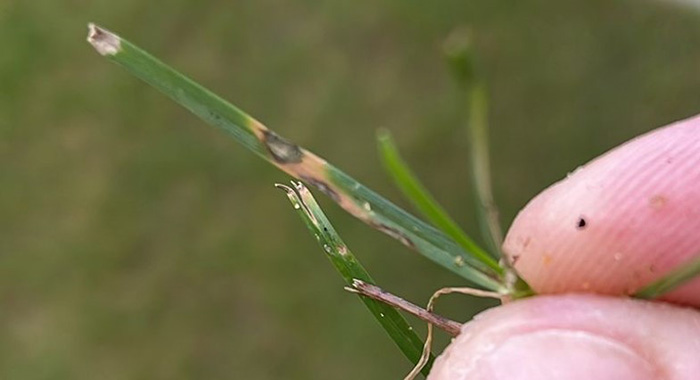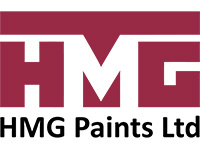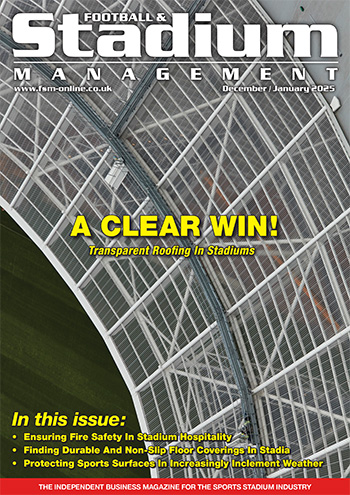Knowledge Is Power In The Defence Against Gray Leaf Spot

By Kelly-Marie Clack, Agronomy Technical Manager.
At the heart of any football stadium lies the pitch, vital for the game's aesthetics and performance. Maintaining pristine playing surfaces can prove challenging, particularly when faced with a major threat such as Gray Leaf Spot (GLS). This fungal disease, caused by the pathogen Pyricularia grisea, presents a serious challenge for turf managers. Capable of causing significant damage when environmental conditions are favourable, to any stadium pitch. In this article, Kelly‑Marie Clack from Origin Amenity Solutions delves into GLS and explores effective turf management strategies.
Gray Leaf Spot (GLS) is a foliar disease which on initial inspection, in perennial ryegrass, can look like drought stress or heat stress. On closer inspection, lesions are visible with purple‑coloured margins and a yellow boundary. GLS is a fast‑acting disease and therefore the lesions are only visible for a short time before the leaf decays completely. The upper portion of the leaf can become twisted and turn brown, but this is not always visible due to regular cutting. Perennial ryegrass is most susceptible 4‑6 weeks after germination. If not identified and treated quickly this disease can destroy a pitch in 3‑5 days.

As with many diseases environmental factors such as temperature, humidity, and leaf wetness are major factors in the development of GLS. As the temperature increases the duration of leaf wetness required for fungal spore infection decreases. The disease can be spread through spores in the air or by contamination from foot traffic or machinery.
Early diagnosis of this disease is essential as the fungus will complete cycles of infection and the spore levels will increase until the turf dies.
Steps To Regular Testing:
- Take clippings daily and incubate the leaf tissue in a warm, humid ziplock bag overnight. A grey mold can often appear on the leaf tissue if GLS is present.
- If you see signs of drought stress, use a moisture meter to determine if it is drought (low moisture readings.) If moisture is adequate do not apply excessive water. Remember, high temperatures and high humidity environments only require leaf wetness of around 9 hours to incubate this fungus.
- Take a soil sample including the leaf tissue, in the infected area. Wrap tightly to avoid soil contaminating the leaf tissue. For analysis send to Dr Deborah Cox at Lagan Valley Scientic or Dr Kate Entwistle at the Turf Disease Centre.
- This position will be the area you test first each year as the disease commonly develops in the same area year on year.
- This disease is rapid, mark the boundary of the disease patch and reassess the following day.

Plan To Reduce The Risk Of GLS:
- It is important to take an integrated approach to GLS management due to the rapid spread of the disease. Collecting environmental data from an onsite weather station and agronomic data from the pitch will help support your management decisions and reduce the risk of this disease damaging the whole sward.
- You only require enough water for plant health and surface safety. Use a moisture meter to make water management decisions. Incorporate a wetting agent programme to reduce watering requirements and decrease surface tension so that water penetrates the profile quickly. Do not irrigate in the early evening as the leaf will be wet for up to 12 hours through the night.
- Fans can be used to improve airflow in a stadium environment. This will reduce air temperature and leaf wetness.
- Apply sufficient Nitrogen for turf health and no more. Excessive nitrogen can cause the disease to spread. Controlled‑release fertilisers can be a useful tool in this situation and release small amounts of nitrogen through liquid application.
- Overseed with ryegrass cultivars that have a greater resistance to GLS. Feedback from sites suffering from GLS have seen higher levels of disease resistance and quicker recovery from some Tetraploid cultivars compared to some Diploids. Straight Tetraploid mixes are also available from OAS.
- Good cultural practices are essential. Adequate raking to create a sward with good air movement at the base of the plant and a clean cut with sharp mower blades to reduce the risk of the disease entering the plant can help prevent infection. Avoid mechanical practices on the surface when it is wet as this will move the spores into unaffected areas.
- Preventative fungicides should be used to reduce the risk of GLS. Research has shown the most effective curative fungicide is Azoxystrobin, but Europe is seeing evidence of resistance to this chemical. Rotate fungicide groups to avoid this. Ascernity and Medallion are also known to be effective in a preventative approach.
- UVC machines can be a useful tool to reduce spore activity on the leaf, but they will not affect the spores in the soil. The UV‑C light will only kill spores on the side of the leaf the light hits, therefore you will need to brush the turf in the other direction to cover the whole leaf.
- Hygiene is extremely important when controlling the spread of this disease. All equipment and shoes (everyone who goes onto the pitch) should be disinfected so that spores are not transferred from one pitch to another. Disinfectant sprays such as EndoSan will have no adverse effect on the turf. Disinfectant mats are also worth considering. We have seen GLS on several training grounds due to contamination, high humidity and leaf wetness.
Don’t forget to work with renovation contractors and any other contractors you have onsite to ensure all equipment is disinfected before work is carried out on the pitch and when they finish to avoid the spread of GLS.

For advice or product information contact Origin Amenity Solutions Area at www.originamenity.com or email us at This email address is being protected from spambots. You need JavaScript enabled to view it.
Click the article to enlarge it.












































